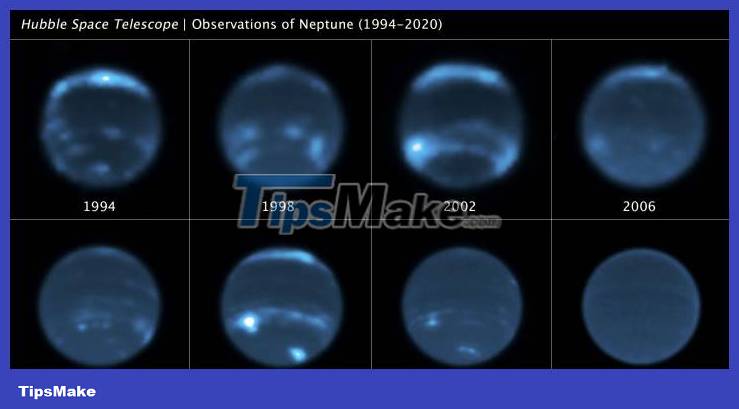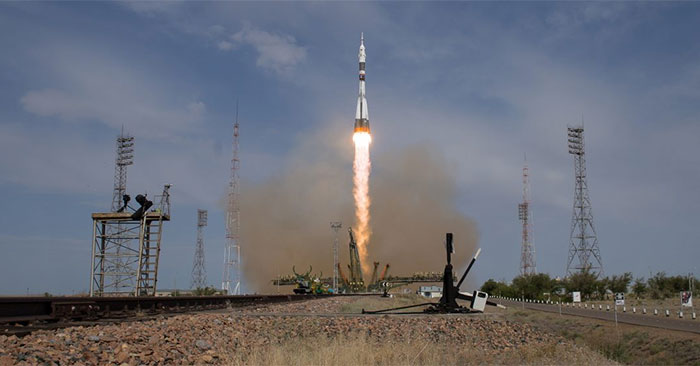Clouds on Neptune may be created by the Sun
Orbiting nearly 3 million miles from the sun, Neptune is distant from Earth. However, the knowledge we have about the atmosphere and weather conditions on this planet is not at all little. Violent storms were observed on Neptune when the Voyager 2 spacecraft passed by the planet in the early 1980s. They were accompanied by dark spots surrounded by white clouds of frozen methane gas. cold. Even so, astronomers are now facing a conundrum about the origin of these storms, and why they seem to continuously appear and disappear over time in an endless loop. .
Researchers recently used Hubble and other advanced telescopes and observatories to observe Neptune's clouds to investigate a mystery: Why does the planet sometimes have very There are many clouds in its atmosphere, while at other times there are almost none. For example, in 2019, Neptune's cloud amount decreased significantly for unknown reasons.
As a result, the team found a connection between Neptune's cloudiness and the 11-year solar cycle. At certain times, the number of sunspots and solar flares increases, emitting more ultraviolet (UV) radiation into the solar system. This radiation appears to influence the clouds on Neptune, as the study shows over 30 years of data that more clouds appear two years after the peak of the solar cycle. Researchers attribute this two-year lag to the fact that chemical processes begin in the planet's atmosphere and take time to create the clouds.
 Clouds on Neptune may be created by the Sun Picture 1
Clouds on Neptune may be created by the Sun Picture 1
Neptune is the most distant large planet in the solar system, receiving only about 0.1% of the intensity on Earth. However, the changes in the clouds that cover Neptune appear to be driven by solar activity rather than the four seasons, each lasting about 40 years, on the planet.
'These remarkable data provide us with the strongest evidence yet that Neptune's cloud cover is correlated with the solar cycle. This finding supports the hypothesis that the Sun's UV rays, when strong enough, can trigger the photochemical reaction that creates Neptune's clouds,' said Dr. Imke de Pater, a member of the research team. know.
Currently, cloud cover on Neptune is very low, except for some clouds hanging over the planet's south pole. A team of astronomers discovered that the cloudy region typically found near Neptune's equator began to decrease in 2019.
Going forward, researchers want to continue monitoring Neptune's cloud activity to understand how the sun affects the clouds, and whether clouds will reappear at previous levels.
You should read it
- NASA discovered water in planetary Neptune's atmosphere
- The planet has the fastest wind in the solar system, reaching a speed of 2,400 km/h
- How the Sun will look when viewed from other planets
- Discover a new dwarf planet about the size of a Pluto in the Solar System
- Discover incredible facts about our cosmic planet
- NASA declares the existence of the 9th planet in our Solar System
- If 'stray' to any planet in the solar system, what is your chance of survival?
- How big is the solar system?
- why do clouds have a lot of colors?
- The mystery and the irresistible beauty of nacre clouds
- NASA announces 10 new 'copies' of Earth that we now know
- Mourning the fate of the first Soviet submarine
May be interested

How many planets are there in the universe?

Why are the stars in the universe spherical and not square or rectangular?

Video: Russia launches the first lunar probe in nearly 50 years

The majesty of the largest galaxy cluster ever known under the eyes of the $10 billion telescope

Detecting a mysterious question mark in the universe

Lonely star glitters in the background of an amorphous galaxy in the eyes of the Hubble telescope






 why do clouds have a lot of colors?
why do clouds have a lot of colors? The mystery and the irresistible beauty of nacre clouds
The mystery and the irresistible beauty of nacre clouds The planet has the fastest wind in the solar system, reaching a speed of 2,400 km/h
The planet has the fastest wind in the solar system, reaching a speed of 2,400 km/h NASA discovered water in planetary Neptune's atmosphere
NASA discovered water in planetary Neptune's atmosphere Guide to blending clouds into beautiful and simple photos
Guide to blending clouds into beautiful and simple photos Instructions to combine clouds into beautiful and simple photos using PicsArt
Instructions to combine clouds into beautiful and simple photos using PicsArt